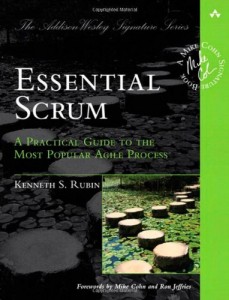《Essential Scrum》作者Kenny Rubin采访录-亚马逊最畅销敏捷项目管理书
1. 最想问不同的企业文化和价值观,以及商业定位对于敏捷的适用性有什么具体的影响?
What’s challenge for adopting agile with different company culture, core value and business?
There is no one way or template to adopt Agile. No one can lead you down a predefined path that will guarantee success. Instead, you must learn, inspect, and adapt your way forward based on your organization’s own unique goals and culture and the ever-changing complex environment in which you must operate. Regardless of your adoption path, the people within the organization must have the courage to address impediments when the see them. It is easy to change core Scrum values and principles when they conflict with the way the organization operates today. To be successful, you must be willing to face these impediments and take the difficult (and often unpopular steps) to address them.
对于Agile转型没有统一的方法或模板。也没有一条预定义好的路能保证成功。相反,基于组织自己独特的目标、文化及不断变化的复杂环境,你必须学习、检视与适应向前的路。不考虑转型的路径,当发现障碍时,组织内的人们必须有勇气解决。当Scrum与组织当前经营方法有冲突时,改变Scrum核心价值与原则很容易。为了成功,你必须愿意面对这些障碍并把困难(经常是不受欢迎的措施)解决掉。
2. 现在的很多情况是研发团队对于敏捷或者Scrum方法的采用较为普遍,但是销售市场或产品部门并不一定采纳的很好,这个怎么解决
It is very common to adopt agile/scrum in R&D team, how to embrace scrum by sales, marketing or product organization?
Scrum is a set of values and principles that can be applied in a number of environments. These values include honesty, openness, courage, respect, focus, trust, empowerment, and collaboration. These values can and should guide the work that is performed in sales, marketing, and other organizations. The core principles of Scrum also apply outside of development. For example, limiting work in process (WIP) is just as important in a marketing environment as it is in a product development environment (working on too much of anything at the same time slows you down and reduces quality). Organizing the work for fast feedback is also an important principle that should apply outside of development. You want to know early if your marketing or sales campaign is properly designed to achieve its goals. Also, working in timeboxed iterations has the same benefits in non-product development environments. For example, it forces prioritization, helps demonstrate progress quickly, avoids unnecessary, motivates closure, and improves predictability. These are benefits that apply in many different contexts.
Scrum是一套可以应用与多个场景的价值与原则。这些价值包含诚实、开放、勇气、尊重、关注、信任、授权与协作。这些价值应该可以指导销售、市场与其他组织的工作。Scrum核心原则也适用于开发组织之外。例如,限制在制品(WIP)在市场部门与产品开发部门一样重要(同时工作在太多的事情上会让你慢下来及降低质量)。组织工作的快速反馈也是一个应该适用于开发之外的重要原则。另外,在非产品开发部门用时间盒迭代方式工作也有同样的好处。例如,它促进优先级排序,帮助快速演示进度,避免不必要的完美主义,及提高预见性。这些都是适用于不同场景的好处。
3. CMMI和敏捷(Scrum)是否能够融合在一起? 二者融合在一起是否比单采用其中的一种效果更好?
Could Scrum and CMMI co-exist in a organization together? OR which one is better between co-existing and choosing one?
Yes! I have frequently worked with companies that are simultaneously adopting Scrum and trying to achieve CMMI level 3 (or are already doing both). The two are not inherently contradictory. CMMI assesses the maturity of an organization and its ability to repeatedly apply its defined process. It doesn’t stipulate that the process has to be traditional (Waterfall) or Agile. So it is possible to perform Agile in and environment that is CMMI compliant. In such an environment you will likely do a bit more documentation than you would in an Agile environment without CMMI, but if people are willing to practical about its application, good results can be achieved.
Scrum与CMMI可以融合在一起。我经常和这样的公司工作,它们同时采用Scrum也尝试达到CMMI 3(或者已经都在用这两个方法)。Scrum与CMMI不是天生对立的。CMMI评估组织的成熟度及重复应用定义好的流程的能力。它没有规定流程必须是传统的瀑布式或Agile。因此有可能在组织内执行与CMMI兼容的Agile。在这样的组织内可能比不用CMMI的Agile组织多一些文档工作,但如果人们愿意尝试这样的方式,也会收获很好的结果。
4. 一些保守的企业认为采取敏捷会削弱领导层对员工的控制力,应当如何说服这些企业尝试使用敏捷?
How to persuade people to try agile, those who think agile will weaken the control to employees in some traditional company?
Many people are concerned that if they move from a traditional product-development approach like Waterfall to Scrum that they will lose control. In Waterfall there are very well-defined checkpoints where managers can review the progress and decide if they want to fund the next phase. Some managers are concerned that these checkpoints will go away and development with Scrum will be chaotic.
This concern is unfounded. First, using Waterfall, there were only a few of these checkpoints and there could be many months between them (perhaps a checkpoint every quarter or half a year).
Scrum provides managers, stakeholders, product owners, and others with many more checkpoints than they would have with sequential projects. At the end of each short sprint there is a meaningful checkpoint (the sprint review) that allows everyone to base decisions on demonstrable, working features. People are better able to deal with a complex environment when they have more actionable checkpoint opportunities to inspect and adapt. So, I believe there is actually much more control in an Agile project than a traditional project!
许多人担心如果从传统的产品开发方法如瀑布式转变到Scrum,他们将失去控制。在瀑布式开发中,有定义良好的检查点,经理们可以检查进度并决定他们是否会投资下一步。有些经理担心这些检查点会消失,以及用Scrum开发会是混乱的。
这种担心是没有理由的。首先,采用瀑布式开发,只有很少的检查点,两个检查点之间可能是好几个月(或许一个季度或半年一个检查点)。
Scrum比顺序开发的项目提供给经理、利益相关人、产品负责人及其他人更多的检查点。在每个短的迭代结束时,有一个有意义的检查点(sprint review会议)允许每个人在演示、可工作的特性达成一致决策。当人们有更多可行动的、检视与适应的检查点机会时,他们会更好的处理复杂环境。因此我相信Agile项目比传统项目实际更加可控。


